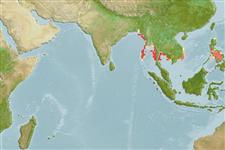Elasmobranchii (sharks and rays) >
Orectolobiformes (Carpet sharks) >
Hemiscylliidae (Bamboo sharks)
Etymology: Chiloscyllium: Greek, cheilos = lip + Greek, skylla = a kind of shark (Ref. 45335). More on author: Bleeker.
Environment / Climate / Range
Ecology
Marine; reef-associated; depth range 0 - 12 m (Ref. 90102). Tropical, preferred ?; 23°N - 10°N, 91°E - 133°E
Indo-West Pacific: Thailand, Singapore, Malaysia, Indonesia, Myanmar and Vietnam.
Size / Weight / Age
Maturity: Lm ? range ? - ? cm
Max length : 61.0 cm TL male/unsexed; (Ref. 106604)
Dorsal
spines
(total): 0;
Dorsal
soft rays
(total): 0;
Anal
spines: 0;
Anal
soft rays: 0. Caudal fin with a pronounced subterminal notch but without a ventral lobe (Ref. 13575). Juveniles with dark grey-brown bands outlined in black, adults uniform medium- to dark-brown color, the black edgings being the last parts of the color pattern to disappear (Ref. 13575).
A common inshore bottom-dweller (Ref. 13575); on rock and coral reefs (Ref. 90102). Feeds on invertebrates (Ref. 13575). Oviparous (Ref. 50449). Utilized for human consumption (Ref. 13575). Minimum depth from Ref. 58018.
Life cycle and mating behavior
Maturity | Reproduction | Spawning | Eggs | Fecundity | Larvae
Oviparous, paired eggs are laid. Embryos feed solely on yolk (Ref. 50449). Distinct pairing with embrace (Ref. 205).
Compagno, L.J.V. and V.H. Niem, 1998. Hemiscylliidae. Longtail carpetsharks. p. 1249-1259. In K.E. Carpenter and V.H. Niem (eds.) FAO identification guide for fishery purposes. The Living Marine Resources of the Western Central Pacific. FAO, Rome. (Ref. 13575)
IUCN Red List Status (Ref. 115185)
CITES (Ref. 94142)
Not Evaluated
Threat to humans
Harmless
Human uses
Fisheries: commercial
More information
ReferencesAquacultureAquaculture profileStrainsGeneticsAllele frequenciesHeritabilityDiseasesProcessingMass conversion
Tools
Special reports
Download XML
Internet sources
